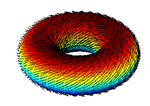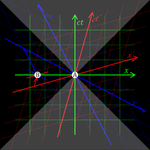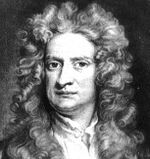Light-year
A light year is an astronomic unit length created so that scientists could express distances between stars and galaxies using less than twenty-five zeros. A light year is equal to the distance light covers over a year, for which the technical term is "really fucking far."
History[edit]
In the XVII century, scientists discussed whether or not light had infinite speed. It was up to Sir Isaac Newton, inventor of 80% of all science, to tell these amateurs they were wrong, as always. Here's the transcript, translated to Modern English, of a correspondence between him and rival John Hooke.
Dear Mr. Isaac Newton,
It pains me to waste such expensive ink and wear out such a fine feather on a letter to you, but I am bound by my obligations to Science to cooperate with my colleagues, however unbearably smug they may be. I have recently read your new book, Opticks, an experience with as much entertainment value as staring at a wall. However, of the words you used that aren't known only to dictionaries, I could gather some -- I'll admit -- promising ideas regarding the nature of light.
My own observations, based on those of your intellectual superior Mr. Johannes Kepler, lead me to believe light has infinite speed. These observations included experiments such as lighting a candle and trying to see light expanding to fill the room, but that happened instantaneously, therefore the conclusion is that light's speed is infinite.
Some times things are just that simple, Mr. Newton.
Respectfully,
John Hooke.
And Newton's response:
Hooke, you arsehole,
It pains me to devote even a second of thought to how much I hate you, so writing you a letter is slightly more unpleasant than pouring boiling oil on my balls. Still, I have to agree with you on my obligations to Science, but not on you being my colleague, for I happen to be a scientist.
But I'm somewhat touched that you took time from stealing ideas off real scientists to ask Daddy Newton for some advice. Sadly, I am unable to build upon your observations because they are unsurprisingly wrong. I am fairly certain that Mr. Kepler, a brilliant scientist regardless of a few mistakes, arrived at his conclusions with methods significantly more complex than trying to follow light with his eyes.
For you see, Hooke, even though your eyes are remarkably agile -- especially when looking for other people's work to claim as your own -- light is too fast to be followed by them, or any human eye. Light is not infinite, it's just really fucking fast.
Some times, things are just that simple to simple-minded people such as yourself, you arse-licking cunt.
Hatefully,
Isaac Newton.
Scientists decided to back the guy who discovered gravity, and after the speed of light was properly measured, they tried to think of a really cool name for the distance light covers in a year. Some guy suggested the "parsec" and was promptly laughed at.
Empirical evidence[edit]

The problem with the light-year is that measurement of how far light travels in a year requires, well, a year. For this reason, scientists instead rely on "thought experiments." The most famous of these was the one devised by Albert Einstein, in which a scientist, riding in a train proceeding at almost the speed of light, points a flashlight forward and turns it on. Einstein found that, under those conditions, instead of a solid beam projecting forward, the light dribbled out and in fact some of it dripped onto the floor.
Happily, the train belonged to Britrail. This meant that the stain on the floor was relatively minor, and that the train conveniently took the remainder of the hypothetical year to arrive at its destination.


